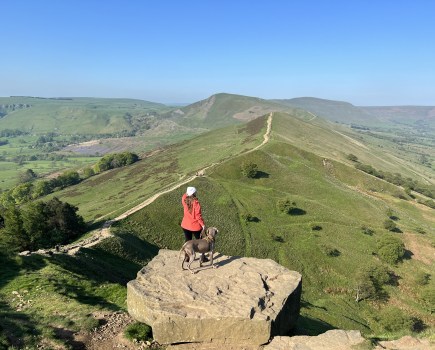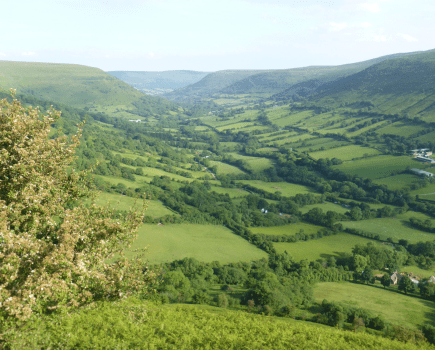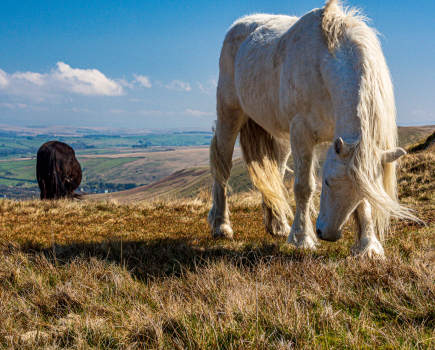Paul Beasley traverses Dartmoor’s ancient bog-scape and sees the stony hand of history at every turn
ONE OF THE PERKS of being a YHA manager is that, every now and then, you can reshuffle your schedule and head into the great outdoors. Garry Hayman, having helped me plot a tour of Dartmoor’s highlights, decides to grab his boots and tag along.
We head south through a conifer plantation, slowly diverging from the brim-full East Dart River that hems its eastern edge. But the normal flow of time seems to stop at the gates of Laughter Hole Farm. Here, enclosed by mossy walls, are gnarled trees shrouded in the goatee straggles of ‘string of sausages’ lichen. Amidst the otherworldliness of this sad-seeming place, Garry points out the tumbled walls of Snaily House across the valley. The property, apparently, got its name from two spinsters who fended off the slow squeeze of starvation by eating snails and slugs. I feel like I’ve wandered into a fairy tale.
A short march brings us out into the drizzleflecked wind of the open moorland. After crossing the bulging lower slopes of waterlogged Laughter Tor, we climb to the shattered granite crown of Bellever Tor. From here, the views of the surrounding undulations of field, wall, forest and hill shift restlessly under a bruised sky. Fleeting sunlight illuminates the grey rocks, then cloud cover turns them as dark as immense stacks of thin, wet peat.
From geology millions of years in the making, we descend through a Neolithic field system – maps of Dartmoor are freckled with such evidence of early human habitation. Ahead of us a pair of cuckoos make a scoopy flight, then disappear into the western edge of the forest. Once across the B3212, we trot towards the Powder Mills over the mudslatheredbog, teleporting forward to the 19th century via a medieval bridleway once used to take bodies to the graveyard at Lydford. As we wend our way down to the old mill building with its boulder-sized masonry, a flock of sheep are mowing the grass near the stillstanding chimney. Spotting a black one, Garry raises an eyebrow and passes judgement: “That must be the chimney sweep’s sheep!”
The rain comes on again as we climb Littaford Tors then drop down to Wistman’s Wood – three tiny copses of trees secreted in the fold of the West Dart River valley. One of the highest oak woodlands in Britain, Wistman’s Wood is a collection of wizened trees draped in the woolly weirdness of more light-green lichen, which also grows in spikes atop some of the bigger branches like arm hairs standing on end. The overall effect is so magical that I half expect to find Gandalf sitting on one of the moss-covered boulders, puffing away on his pipe.
We climb back up to the ridgeline of tors, passing ponies munching on a landscape that rolls away green into the mid-ground, then reappears straw yellow, then rears up again as a background grey against a chalky sky.
Picking our way over knotty tufts of grass, up onto Higher White Tor then Lower White Tor, then onto Broad Down and beyond, the East Dart River – made brown and boisterous by the incessant rain – eventually bars our way. Fifteen minutes later we’ve clambered and hopped across and follow the river’s course round to a bridleway and stop for lunch in a sizzle of rain next to the remains of a beehive-shaped stone hut.
We head south, gently angling away from the river and towards Hartyland Tor in a vain attempt to avoid the worst of the quagmire. As we squelch onwards, I’m reminded of an anonymous poem I once read, by a local schoolchild: “Wet and boggy / Cold and soggy / Deep and smelly / Pulls off my welly.” Indeed.
Five hours or so after we set off, we’re surveying Postbridge’s picturesque clapper bridge – a medieval-era river-crossing made by laying huge slabs of granite over columns of smaller rock stacked in the water.
Garry then leads me into the village shop for a chat with its owner and onto the visitor centre, before we re-enter the forest at Bellever to access Lakehead Hill – where the stone rows, cairns and cists of Neolithic and Bronze Age man ooze into the deeper time of geology. Amidst the gathering gloom of a final dash through the trees, a thrush pierces the silence. At least I think it was a thrush – I’m often wrong about such things. Maybe it was a pterodactyl.
ROUTE DESCRIPTION
- Follow track S through forest. Go through several gates and take R fork just beyond Laughter Hole Farm. Path turns SW just before boundary wall. Go through gate and walk 600m across open moorland on bridleway.
- Turn R onto grassy path up gentle slope towards corner of field. Go through gate and head directly up onto Bellever Tor, then continue N through clearing in forest, passing prehistoric field system on way.
- Turn left on to bridleway (Lich Way), heading towards trees, and walk 500m, taking second clear path to right through forest, marked with finger post. Follow path to B3212 and cross road, passing through gate marked ‘Gawler and Powdermill Newtake’. Ruins of powdermill, in copse, are due W, but path heads NW first (look out for small marker posts) before turning SW near brook. Go through gate and follow track to powdermill, cross bridge and continue pastchimney. Go through gate and head almost due W for 1km, heading for gate in boundary wall as you climb up to Littaford Tors. Continue due W down slope to Wistman’s Wood.
- Climb back to Littaford Tors and head due N to Longaford Tor, then NNE to Higher White Tor and N to Lower White Tor and corner of boundary wall. Turn NE to follow wall 1km, fording several brooks. Then N over Broad Down to East Dart River waterfall and ford river.
- Turn E to loosely follow flow of river, passing ruined ‘beehive hut’. Take a course almost due S for 2km along path, heading directly along ridge to Hartland Tor, avoiding boggier ground closer to river. Head S from Hartland Tor, pass through two gates alongside river, then follow path clockwise around perimeter of field, joining B3212 near Inn at Postbridge. Cross road and drop down by bridge to Clapper Bridge.
- Head left along road for 200m and take left turning into Bellever Forest car park. Take L then first R track, then turn L on path and climb S onto Lakehead Hill, passing prehistoric sites. Turn L onto bridleway (Lich Way) and follow path 1km into Bellever.
Paul Beasley traverses Dartmoor’s ancient bog-scape and sees the stony hand of history at every turn
ONE OF THE PERKS of being a YHA manager is that, every now and then, you can reshuffle your schedule and head into the great outdoors. Garry Hayman, having helped me plot a tour of Dartmoor’s highlights, decides to grab his boots and tag along.
We head south through a conifer plantation, slowly diverging from the brim-full East Dart River that hems its eastern edge. But the normal flow of time seems to stop at the gates of Laughter Hole Farm. Here, enclosed by mossy walls, are gnarled trees shrouded in the goatee straggles of ‘string of sausages’ lichen. Amidst the otherworldliness of this sad-seeming place, Garry points out the tumbled walls of Snaily House across the valley. The property, apparently, got its name from two spinsters who fended off the slow squeeze of starvation by eating snails and slugs. I feel like I’ve wandered into a fairy tale.
A short march brings us out into the drizzleflecked wind of the open moorland. After crossing the bulging lower slopes of waterlogged Laughter Tor, we climb to the shattered granite crown of Bellever Tor. From here, the views of the surrounding undulations of field, wall, forest and hill shift restlessly under a bruised sky. Fleeting sunlight illuminates the grey rocks, then cloud cover turns them as dark as immense stacks of thin, wet peat.
From geology millions of years in the making, we descend through a Neolithic field system – maps of Dartmoor are freckled with such evidence of early human habitation. Ahead of us a pair of cuckoos make a scoopy flight, then disappear into the western edge of the forest. Once across the B3212, we trot towards the Powder Mills over the mudslatheredbog, teleporting forward to the 19th century via a medieval bridleway once used to take bodies to the graveyard at Lydford. As we wend our way down to the old mill building with its boulder-sized masonry, a flock of sheep are mowing the grass near the stillstanding chimney. Spotting a black one, Garry raises an eyebrow and passes judgement: “That must be the chimney sweep’s sheep!”
The rain comes on again as we climb Littaford Tors then drop down to Wistman’s Wood – three tiny copses of trees secreted in the fold of the West Dart River valley. One of the highest oak woodlands in Britain, Wistman’s Wood is a collection of wizened trees draped in the woolly weirdness of more light-green lichen, which also grows in spikes atop some of the bigger branches like arm hairs standing on end. The overall effect is so magical that I half expect to find Gandalf sitting on one of the moss-covered boulders, puffing away on his pipe.
We climb back up to the ridgeline of tors, passing ponies munching on a landscape that rolls away green into the mid-ground, then reappears straw yellow, then rears up again as a background grey against a chalky sky.
Picking our way over knotty tufts of grass, up onto Higher White Tor then Lower White Tor, then onto Broad Down and beyond, the East Dart River – made brown and boisterous by the incessant rain – eventually bars our way. Fifteen minutes later we’ve clambered and hopped across and follow the river’s course round to a bridleway and stop for lunch in a sizzle of rain next to the remains of a beehive-shaped stone hut.
We head south, gently angling away from the river and towards Hartyland Tor in a vain attempt to avoid the worst of the quagmire. As we squelch onwards, I’m reminded of an anonymous poem I once read, by a local schoolchild: “Wet and boggy / Cold and soggy / Deep and smelly / Pulls off my welly.” Indeed.
Five hours or so after we set off, we’re surveying Postbridge’s picturesque clapper bridge – a medieval-era river-crossing made by laying huge slabs of granite over columns of smaller rock stacked in the water.
Garry then leads me into the village shop for a chat with its owner and onto the visitor centre, before we re-enter the forest at Bellever to access Lakehead Hill – where the stone rows, cairns and cists of Neolithic and Bronze Age man ooze into the deeper time of geology. Amidst the gathering gloom of a final dash through the trees, a thrush pierces the silence. At least I think it was a thrush – I’m often wrong about such things. Maybe it was a pterodactyl.
ROUTE DESCRIPTION
- Follow track S through forest. Go through several gates and take R fork just beyond Laughter Hole Farm. Path turns SW just before boundary wall. Go through gate and walk 600m across open moorland on bridleway.
- Turn R onto grassy path up gentle slope towards corner of field. Go through gate and head directly up onto Bellever Tor, then continue N through clearing in forest, passing prehistoric field system on way.
- Turn left on to bridleway (Lich Way), heading towards trees, and walk 500m, taking second clear path to right through forest, marked with finger post. Follow path to B3212 and cross road, passing through gate marked ‘Gawler and Powdermill Newtake’. Ruins of powdermill, in copse, are due W, but path heads NW first (look out for small marker posts) before turning SW near brook. Go through gate and follow track to powdermill, cross bridge and continue pastchimney. Go through gate and head almost due W for 1km, heading for gate in boundary wall as you climb up to Littaford Tors. Continue due W down slope to Wistman’s Wood.
- Climb back to Littaford Tors and head due N to Longaford Tor, then NNE to Higher White Tor and N to Lower White Tor and corner of boundary wall. Turn NE to follow wall 1km, fording several brooks. Then N over Broad Down to East Dart River waterfall and ford river.
- Turn E to loosely follow flow of river, passing ruined ‘beehive hut’. Take a course almost due S for 2km along path, heading directly along ridge to Hartland Tor, avoiding boggier ground closer to river. Head S from Hartland Tor, pass through two gates alongside river, then follow path clockwise around perimeter of field, joining B3212 near Inn at Postbridge. Cross road and drop down by bridge to Clapper Bridge.
- Head left along road for 200m and take left turning into Bellever Forest car park. Take L then first R track, then turn L on path and climb S onto Lakehead Hill, passing prehistoric sites. Turn L onto bridleway (Lich Way) and follow path 1km into Bellever.








